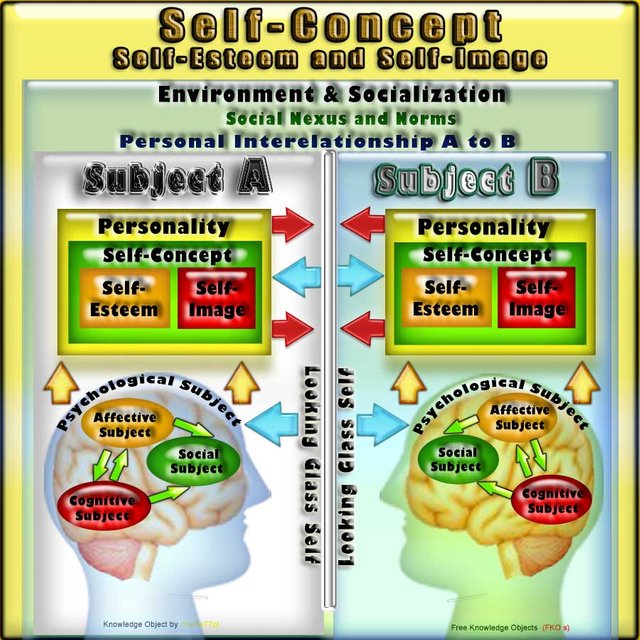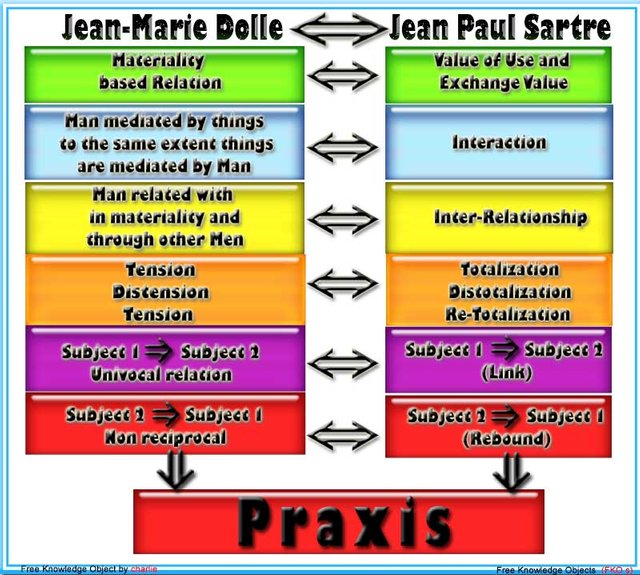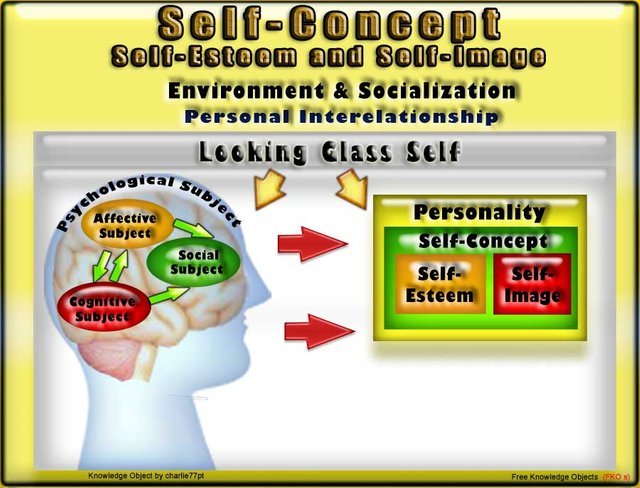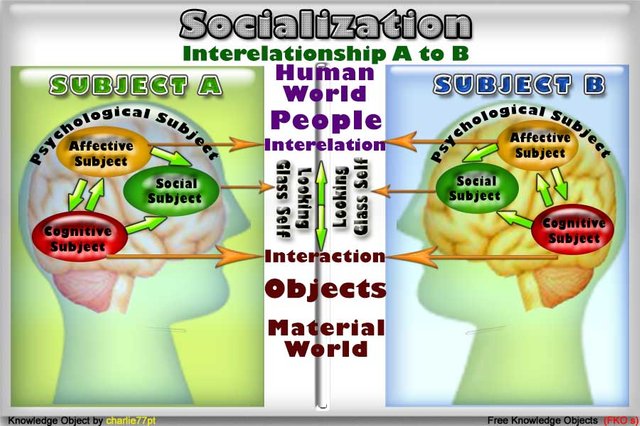Self-concept, Self-Esteem and Self-Image - The Human Nature Part 1
Self-concept, Self-Esteem and Self-Image - The Human Nature Part 1
As promised here is my post on Self-esteem, Self-image and Self-Concept generated trough the Looking-glass-self as the big developers of the personality in socialization
1- The Lost paradigm of Human Nature or the Establishment of a Theoretical Model
Prelude
In this post we will devote our attention to the way that in the development of an individual since birth, a certain type of socialization processes participate in the formation of the Self-Concept.
The problem will be put in the direction of, in its ontogenesis, find a causal function inherent to the process of socialization.
The self-concept in this essay consists of two parts, the Self-Image (how the person sees himself) and self-esteem, (value that a person attaches itself). feeding in the Looking Glass Self
(the way we think the others see us)
This Looking Glass Self
is the vortex of the formation of Personality with the dynamics of the psychological or epistemic subject (dynamic) that works by the interaction of 3 subjects:
The cognitve subject, the affective subject and the social subject , this last one being a form of social dynamics pattern in inter-relationships, under social and cultural contingencies
Note Treshold
The work is focused on key concepts. So be prepared for a hard reading if you want to understand the impossible description of the Human Nature and psychology in 6 or 7 pages
For people who wants to know more the continuing essay is a difficult reading theory, because it requires the integration of bio-social-social, genetics, culture and environment in a multidisciplinary approach with the common mechanisms of lots of sciences and authors from child and Adult psychology , anti-psychiatry, existentialism, economy, to integrate the Self-Concept with child and human development of Personality through the Socialization Process
The need to transpose to such a short space, a vast field of goals, determined a long conceptual elaboration that presumably interfere with the intelligibility of its long reading, suggesting the use of the Synoptic Table below before starting to read, for the visualised perception of the multitude of the structures involved.
Mantra viewer of all the concepts envolved in this post
The Lost paradigm of Human Nature or the Establishment of a Theoretical Model
The Subject
Piaget's work is directed to study the cognitive structures (its subject), reducing the affective component of the energy behavior, assimilating it to the motivation that is the body's needs.
It does not deny however that the cognitive and affective processes are developed in parallel, but in its psycho-sociological perspective (formation of the child's moral judgment) only based on the hypothesis of a correspondence between the structuring that drive individual's cognitive activities and those involved in social interactions.
This hypothesis brings us the status of problem of behavior observed in social interactions.
Do they only depend on a certain level of cognitive development?
Or are they the source of both a cognitive and social development, which are a determining factor?
In this work, the "subject" considered by Piaget does not clarify the problem of causality in the formation of self-concept, it only highlights the fact that social interaction plays a decisive role in the spiral development of cognitive structures.
It makes no sense to Piaget speak of emotional structures.
It is here that J. Marie Dolle although according to Piagetian conception of intelligence as a form of adaptation, it demarcates from this author conceives and affectivity in order to adapt to people, such as cognitive processes has a parallel development to the theory of cognitive stages with structures and structuring.
Dolle distinguishes the  from
from  an he considers the inter-relationship as a situation in which the object of interaction is another subject (Subject 2) responsive to the action of Subject 1.
an he considers the inter-relationship as a situation in which the object of interaction is another subject (Subject 2) responsive to the action of Subject 1.
Is then through the interrelation that we conceive the affectivity.
The interrelationships arise incidentally first of interactions, because in the construction of the permanent object in the child, the basis of all subsequent cognitive development begins with an interrelation, the objectal relation to the mother.
The affective and cognitive processes appear linked to two different logics, respectively the logic of contradiction and the logic of non-contradiction.
In the logic of contradiction, affirmation and negation are simultaneously applied to the same object by the same subject, this ambivalence situation Sartre refers to as the anguish of choice.
Dolle believes that the development process vary between these two approaches, now prevailing affectivity (update) and maintaining the enhanced intelligence, or updating to intelligence and enhancing to affectivity, a rhythmic process but at all times both are present and in constant interdependence.
Dolle also speaks of oscillations between tensions (arthis) and distensions (thesis).
The most important part of his theory is the attempt to create an explanation for the dialectical process of updates and potencialization of intelligence and affectivity. For Dolle affectivity comes as energy as repercussions (retentissement) and as a link (attachment).
Considers the development process as a result of interaction between a subject affective and cognitive subject, and as a result a social subject, which only will one stage to another by the initial mediation of affectivity.
The variable affection as resistance to the fitting structures of epistemic subject , translates he mediator effect on Subject 2 over Subject 1 to allow Subject 1 a greater differentiation of those structures of adaptation.
Dolle favors cognitive structures subordinating them to the affectivity, and creates an epistemological paradigm of affectivity and intelligence, the inter penetration between the logic of antagonism and equivalence.
An empty part to consider in Dolle study will be of little relevance given the socialization process because their inter-relational analysis does not exceed the boundary of the subjects, reducing the process to its effects either S1 (rebound) or S2 (link) .
We will try to fill this void through the existential dialectic of Sartre.
Sartre believes that man is mediated by things the same extent that things are mediated by Man, this Man this related to materiality and through other Men.
Materiality relation referred to above is an example of spirality of dialectical thinking.
This is the kind of analysis necessary for the interpretation of the man in "human scene."
This reasoning allows us to understand the means by which a plurality is constituted as a total, (an "totalization" in the sense of Sartre) or as an whole-subject or a whole-object:
- A totalization is a unifying organization of a plurality and humanity is a plurality of such organizations.
The totalizing relation as the material being , the Man, with the material world is defined by need.
The need de-totalizes the totality creating a dialectic of totalization-distotalization-re-totalization.
Sartre refers to distotalization as "an injection of Nothing in the World" creating with it, a univocal and non-reciprocal relationship, which translates into an individual praxis.
This "nouance" allows us to create a relationship of equivalence between the following concepts of Dolle and Sartre respectively:
This conceptual implementation will allow us to further explain how to form the self-concept (plurality) in a total entity, which will be integrated by their individual praxis in the group and in history, through the socialization process.
- "Matter in man and through man is the motor of history and is a common future." - "Reason and Violence" - R. D. Laing and D. G. Cooper
The socialization process is considered as an example of circularity of dialectical thought, since the individual relations - Environment afect the formation of self-concept, as well as the self-concept affects relations Individual Environment.
The Looking Glass-Self-, major determinant of the genesis of the self-concept in the socialization process, and is the main structural element in the individual praxis.
The comparison with others, the roles and identification with models also determinants of the formation of self-concept in the socialization process, part of the Looking-Glass-Self, structural element of the individual in the group praxis and history.
Now we can present a concise overview of the structure of this work.
1- The Self-Concept
 f [Social Subject (Afective Subject * Cognitve )]
f [Social Subject (Afective Subject * Cognitve )]
But what is the essence of self-concept?
Not to get into unnecessary musings on the nature of the Self, we will adopt the definition of Argyle.
The self-concept in this context consists of two parts, the self-image, how the person sees himself and self-esteem, the value that a person attaches itself.
One way to evaluate the self-image is the application of TST (Twenty-Statement-Test) that consists of twenty answers to the question "Who Am I?".
Argyle cites a study by Mulford and Salisbury where subjects were tested by TST and found four common parts, to focus the analysis on the conditions in which people sees themselves more often:
1 - Family Relations ----70%
2 - Occupation ---------68%
3 - Marital Status -------34%
4 - Religious Identity ----30%
Khun McPartland and applied the TST in an experiment and found that the responses of people appeared equally divided between objective roles or other property as a "woman or married" and personality traits such as "happy or good."
Body image although it is a different order factor is an important part of self-image, it is probably the first part of self-image formed by the child.
Some studies suggest that body size is also important in the self-image as it appears on a learned cultural ideal, which determines how satisfied people are with their bodies.
Self-esteem can be evaluated by applying the SEI (Self-Esteem-Inventory) of Coopersmith.
Coopersmith (1967) in their work based on theoretical and empirical evidence suggests that certain personal characteristics are associated with self-esteem:
1 - Physical Attributes
2 - Affective States
3 - Problems and Pathologies
4 - General Abilities, Skills and "Performances"
5 - Personal Values
Thus, we should remember what the author meant by self-esteem:
"we refer the assessment that the individual does and costumamente remains to be seen himself: it expresses an attitude of approval or disapproval, and indicates the extent to which the individual believes that he is capable, significant, successful and badly -successful".
In short, self-esteem is the personal judgment of valuation that is expressed in the attitudes that the individual takes on themself.
In their study, in the area of physical attributes, it concludes that motor development is correlated with self-esteem, to find that the age at which the child began to walk, had influence on the structuring of self-esteem.
Following is the statistical framework:
Age Subjective self-esteem
Age at which individuals begin to walk Low Medium High
15 months or less ----------------------32.1% (9) 66.7% (10) 60% (18)
More than 15 Months ------------------67.9% (19) 33.3% (15) 40% (12)
Totals--------------------------------- 100% (28) 100% (25) 100% (30)
These results concluded that the earlier a child begins to walk the higher will be your self-esteem. Also discusses on the issues of the physical attributes, size and weight that in this study we did not consider necessary.
We assume that presumably there will be a correlation between the maturation process and the formation of self-esteem.
We will address this issue when we deal with the question of the progressive development of hereditary reflexes.
In the second area, on the affective states, Coopersmith refers to three aspects of affection:
1 - Affection "total"
2 - The extent of the anxiety and stress that the subject expresses
3 - The extent of "happiness" that the individual shows.
"Total" Affection is the measure that the subject expresses in a projective test.
Thus she found that children with high self-esteem, were relatively free of anxiety were more expressive and "happy", while those with low self-esteem had anxiety were less expressive and happy.
The third area related to problems and pathology, found that children with low self-esteem tended to show more psychosomatic symptoms.
In the fourth area, the capabilities and "performance" academic, found that they were associated with feelings of personal valuation.
In the last area, the personal values, found that parents of children with high and low self-esteem, favored the emergence of different values and respectively of school success and social accommodation.
The "Looking-Glass-Self"
Charles Cooley, through the notion of "Looking-Glass-Self" believes that the self-concept depends largely on how the individual interprets the reactions and opinions of preponderant people in the environment.
For Cooley the notion of "Looking-Glass-Self": "through the reactions of others we discover what we are," is important in the study of self-concept, because the way a person sees itself is the product of the way others to come.
It will be important now to note that Laing revealing interpretative element of personal perception, believes that self-concept is formed from what we think are the reactions of others to us. This idea leads to the notion of the "other internalized."
The socialization
Some authors state that the formation of self-concept is only linked to the development of innate abilities therefore more dependent on the biological heredity of the medium influences.
These theories only retain a sense of biological development, since the formation of the self-concept can be influenced along the ripening physiological process.
Others have a different interpretation considering how central focus, the importance of the in ontogenesis of the self-concept, whose training is solely attributed to the interaction of the individual with others.
This meaning reflects a constant dialectic between the process of socialization and self-concept.
Situating us to continue with this perspective consider also be a dialectic between interpersonal relationships and society.
Only then can describe the socialization process of a biopsychosocial subject .
The end of Part 1 - The Lost paradigm or the Establishment of a Theoretical Model
To be Continued.....
Next Chapters
Part 2 - From birth To Individual Praxis
Part 3 & 4 - Praxis of the individual and Matter as Totality
Other Posts on Psychology
Insight as Self Consciousness - Insight as Self Consciousness Insight has a generating mechanism of the Cathartic Process
Adaptation, translation and visual graphics refresh of an article in portuguese made by me and a friend published in the web in 1994 in a site called www.cultkitsch.com and later cultkitsc.org
Bibliography (based in some of the books in portuguese)
DOLLE, Jean Marie, "From Freud to Piaget", Moraes
LAING, R.D. e COOPER, D.G., "Reason and Violence", Vozes
LAING, R.D., "The divided Self", Vozes
OPEN UNIVERSITY, "Social Relationships", Part 2
DOLLE; Jean Marie, "To understand Piaget"
ARGYLE, Michael, "The Psychology of Interpersonal Behaviour", Pelican
PERRET-CLERMONT e ANNE-NELLY, "Construction of Intelligence by Social interaction", Sociocultura
HINDE; Robert A., "Towards Understanding Relationships", AP
PINTO, Jorge Bento, "Sobre a Concepção da Vinculação", Análise Psicológica Nº 1/2 Serie III
LAING; R.D., "The politics of Experience and the Bird-of-Paradise", Vozes
FÉDIDA, P., " Concept and Violence ", Sociocultura
LAPLANTINE, "Ethnopsiquiaty", Vega
MORIN, Edgar, "The Lost Paradigm . The Human Nature", Europa-América
LAING, R.D., "Self and Others", Vozes
Index of the posts
Prelude
Note Treshold
Part 1
1 - The Lost paradigm or the Establishment of a Theoretical Model
- The Subject
- Self-Concept, Self Esteem and Self-Image
- The Looking-Glass-Self
- Socialization
Part 2
2 - From birth To Individual Praxis
- From Libidinal Object to the Permanent Object
- Of Reflexes in the Relationship Systems Mother-Son
- Afterword to the Chapter or Preface Chapter Later
Part 3
3 - Praxis of the individual to Practical-Inert
- Individual Praxis as Totalization
- Human Relations as mediation between different sectors of Materiality
4 - Matter as Totality totalized and a first experience of need
- The Class Being
- Collectives
- Bibliography




